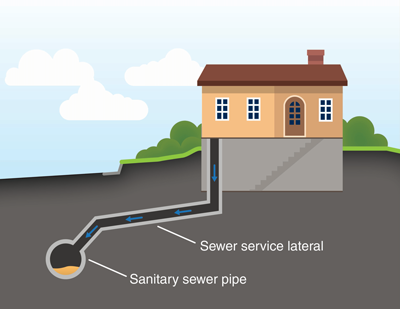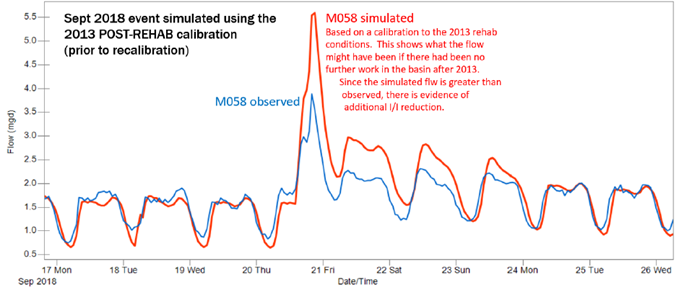 Much like roads and bridges, sewers are designed to handle daily “flush-hour” traffic. Unlike roads, wastewater traffic jams in sewers don’t cause a standstill; the water keeps coming from homes and businesses and the water levels keep rising.
Much like roads and bridges, sewers are designed to handle daily “flush-hour” traffic. Unlike roads, wastewater traffic jams in sewers don’t cause a standstill; the water keeps coming from homes and businesses and the water levels keep rising.
Avoiding extremely high peak flows is one way we reduce the likelihood of a basement backup or overflow of sewage to our lake and rivers. That’s why reducing peak flows from inflow and infiltration (I/I) is so important to the health of the wastewater system and its users.
Recently, the cities of Tonka Bay, Mounds View, Newport, Orono, and St. Anthony Village adopted point-of-sale sewer inspection ordinances. They are among the growing number of cities and townships across the region that are taking action to prevent I/I, which is when stormwater or groundwater enters the wastewater collection system.
Stormwater doesn’t need to be treated like wastewater, and groundwater belongs in underground aquifers. Keeping this water out of the wastewater system keeps it where it belongs in the environment and prevents costly upgrades to the system to accommodate higher flows. I/I can cause backups or unintentional sewage releases into the environment when the water volume gets too high.
Point-of-sale programs help property buyers and sellers find and repair any issues with the sewer service when a home or business is sold. Repairs to the sewers can be costly, so buyers and sellers can negotiate that cost, if needed, as part of the sale price of the home. In 2007, Golden Valley was the first community in the region to adopt a sanitary sewer point-of-sale program as part of their I/I reduction program. Learn about Golden Valley's I/I inspection program..
Local study shows private sewer repairs reduce I/I
A study of wastewater flows in West St. Paul over the last 15 years shows that a comprehensive approach of reducing I/I from both public sewers and private sewer services from homes or businesses can reduce the peak amounts of I/I by 20% to 40%. By prioritizing the locations and sources of I/I that require the most attention, West St. Paul has reduced I/I flows, kept wastewater costs steady with inflation, and reduced sewer overflows to basements and waterways.
How do we know that repairing sewer service laterals are a key part of I/I reduction? Metropolitan Council Environmental Services partnered with West St. Paul to evaluate the city's sewers through a two-part study:
-
Prior to 2013, the city repaired public sewers in two small areas, but there was little reduction in peak flows from this I/I work. After repairs to private service laterals were completed in those areas in 2017, an evaluation of wastewater flow data indicated that between 20% and 25% of peak I/I flow had been eliminated.
-
In another study, we designed a model to use 2004-2013 flow data from the old, unrepaired system to predict what would happen between 2018 and 2020. The predicted flows were then compared to actual 2018-2020 flows in the new, repaired system. The graphic below shows how actual flows (the blue line) during a sample period in 2018 were lower than the predicted flows (the red line), mostly due to the repairs to the sewer service laterals that were part of the point-of-sale program.

The study results show that the largest sewered area of West St. Paul, called the M058 basin, has the most significant I/I reduction corresponding to sewer service lateral repairs dating back to 2008. The estimated peak I/I rate was reduced by about 40% from 2008 through 2017. With more sewer service repairs in the M056 and M057 basins, peak I/I flows can continue to decline.
Financing private sewer repairs for property owners
Some townships and cities with programs to inspect and repair sewer service laterals are offering ways to finance the repairs through loans, grants, or property assessments. Inspections and repairs to sewer service laterals can be expensive, and we continue to seek ways to help offset that burden on property owners and communities.
The repairs are just one part of decades of investments by townships and cities across the region to stop groundwater and stormwater from entering the wastewater system. These efforts have led to:
-
Sewer fees that are roughly 40% lower than the national average
-
No overflows to our rivers and lakes
-
Fewer sewer backups into homes and businesses
Since 2007, communities have reported more than $180 million of sewer-related repairs, including more than $25 million in investments by cities and property owners on service lateral repairs and sump pump disconnections.
More information about I/I
Considering an inspection program?
Cities and townships considering an inspection program can use a model ordinance by the League of Minnesota Cities or contact the MCES I/I Team at [email protected] for assistance and resources.